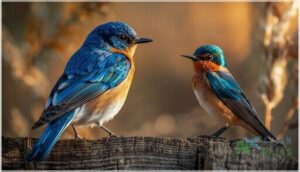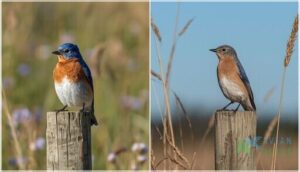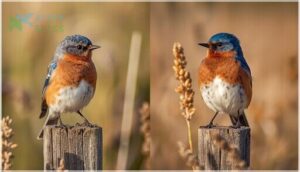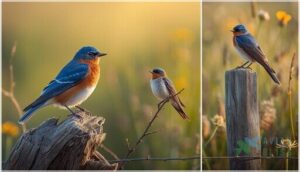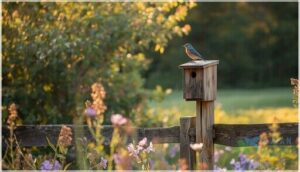This site is supported by our readers. We may earn a commission, at no cost to you, if you purchase through links.
Michigan’s skies hold a flash of blue that stops you mid-step—whether it’s an Eastern Bluebird perched on a fence post or a Blue Jay calling from an oak tree. These vibrant species don’t just add color to your backyard; they play important roles in local ecosystems by controlling insect populations and dispersing seeds across diverse habitats.
From the electric brilliance of Indigo Buntings to the swift aerial maneuvers of Tree Swallows, each blue bird in Michigan brings unique behaviors and ecological needs. Understanding these species helps you identify them correctly, support their populations through thoughtful habitat choices, and appreciate the seasonal rhythms that bring some species back year after year while others remain through harsh winters.
Table Of Contents
- Key Takeaways
- Common Blue Birds in Michigan
- Identifying Blue Birds by Appearance
- Habitats and Distribution in Michigan
- Diet, Behavior, and Breeding
- Conservation and Attracting Blue Birds
- Frequently Asked Questions (FAQs)
- What kind of bird is blue in Michigan?
- Do bluebirds stay in Michigan all year round?
- How to attract bluebirds in Michigan?
- Are bluebirds good to have around?
- What is the average lifespan of a bluebird in Michigan?
- Can bluebirds be found in urban areas of Michigan?
- How do bluebirds protect themselves from extreme weather conditions?
- How do blue birds communicate with each other?
- What predators threaten blue birds in Michigan?
- Can blue birds recognize individual humans?
- Conclusion
Key Takeaways
- Michigan hosts seven blue bird species—Eastern Bluebirds, Blue Jays, Indigo Buntings, and Tree Swallows are common residents, while Cerulean Warblers, Black-throated Blue Warblers, and Mountain Bluebirds appear rarely or seasonally.
- You can identify blue birds by watching for key differences: males display brighter plumage than females, juveniles show spotted patterns before molting into adult colors, and each species prefers distinct habitats from open fields to mature forest canopies.
- Eastern Bluebird populations in Michigan have rebounded to levels higher than in 12,000 years thanks to targeted conservation efforts like nest box programs, volunteer monitoring, and habitat restoration led by groups such as the Michigan Bluebird Society.
- Supporting blue birds in your yard requires three practical actions—installing properly sized nest boxes with predator guards, providing live mealworms and shallow water sources year-round, and planting native berry shrubs like serviceberry and elderberry near open grassy areas.
Common Blue Birds in Michigan
Michigan is home to several striking blue birds, each with its own unique features and habits. If you’re curious about which species you might spot around the state, you’re in the right place.
Here’s a look at the most common blue birds you can find in Michigan.
Eastern Bluebird
Eastern Bluebirds are a signature Bird Species in Michigan, easy to spot thanks to their vibrant blue backs and orange chests. You’ll find them in open fields and orchards, nesting in cavities and boxes. Here’s what sets them apart:
- Population trends show steady growth.
- Nesting habits favor cavities.
- Diet specifics: insects and berries.
- Migration patterns shift seasonally.
- Conservation efforts support healthy numbers. Eastern Bluebirds thrive due to effective bird conservation methods.
Blue Jay
If you’re walking through a Michigan park or your own backyard, the Blue Jay’s bold blue feathers and loud calls make them easy to spot. Known for their intelligence and mimicry skills, these birds help with acorn dispersal and thrive in suburban adaptation. Blue Jays also exhibit interesting nesting behavior, constructing bulky nests in trees. Population trends show they’re a resilient bird species in Michigan.
| Feature | Description | Example Location |
|---|---|---|
| Plumage | Blue, white, black | Forest edges |
| Call | Loud, varied | Suburban gardens |
| Diet | Acorns, insects | Oak woodlands |
| Behavior | Intelligent, social | Neighborhood parks |
| Identification | Crest, bold colors | Bird feeders |
Indigo Bunting
If the Blue Jay’s call grabs your attention, the Indigo Bunting’s electric blue plumage iridescence is sure to hold it. You’ll spot these avian species in Michigan’s brushy fields, especially in summer. Indigo Buntings stand out for their:
- Nighttime migration routes
- Declining population trends
- Breeding success in shrubby habitats
- Sensitivity to habitat loss
Tree Swallow
If Indigo Buntings capture your eye, Tree Swallows might catch your breath with their glossy blue-green backs and swift aerial insectivore habits.
In Michigan, these blue birds thrive thanks to nest box programs, showing impressive population resilience even with some contaminant exposure.
Spot them at migration stopovers or nesting in open fields—true icons of habitat preservation and bird identification.
Cerulean Warbler
Among Michigan’s blue birds, the Cerulean Warbler stands out for its sky-blue back and white belly, nesting high in mature forests. You’ll notice its presence most during spring migration, but spotting one takes patience—habitat fragmentation has led to a sharp population decline. Conservation efforts focus on protecting breeding biology and migration routes, making species identification essential for birdwatching in Michigan.
- Prefers tall, mature hardwood forests
- Population decline due to habitat fragmentation
- Migrates from Michigan to South America
- Conservation efforts target breeding sites
- Identification relies on sky-blue plumage and canopy foraging
Black-throated Blue Warbler
Right beneath the leafy canopy, you might spot the Black-throated Blue Warbler—a secretive guest in Michigan’s forests. With deep blue upperparts and a dark throat patch, they favor mature woodlands where thick shrubs thrive.
The table below highlights key facts for bird identification and conservation, making ornithology approachable for Michigan wildlife enthusiasts:
| Key Feature | Habitat Preference | Conservation Concern |
|---|---|---|
| Deep blue upperparts | Dense understory in mature woods | Stable, but watchful |
| Black throat patch | Large forest patches | Population trends vary |
| Strong site fidelity | Vulnerable to habitat fragmentation | Ongoing efforts |
Mountain Bluebird (rare)
A rare visitor to Michigan, the Mountain Bluebird stands out even among blue bird species. Michigan hosts only a handful of records, usually during migration patterns each spring or fall. Spotting one signals a wildlife conservation story shaped by habitat loss and shifting climate impacts. Conservation efforts target both their dwindling ranges and the ongoing preservation of blue birds:
- bright sky-blue plumage
- rare sightings mostly in northern counties
- prefers open fields or farmlands during migration
- affected by habitat and climate changes
- relies on conservation of blue birds and nest boxes
Identifying Blue Birds by Appearance
Identifying blue birds often comes down to noticing a few key details in how they look. From their colorful feathers to subtle differences between males, females, and young birds, appearance can tell you a lot.
Here’s what to watch for as you spot blue birds in Michigan.
Plumage Colors and Patterns
Ever notice how the blue on a bird’s back can shine like a polished stone? That’s thanks to feather microstructures, not just pigment.
Identification of Blue Birds relies on spotting color intensity, unique patterns, and seasonal changes. For example, Eastern Bluebirds display vibrant blue backs, while Tree Swallows show glossy blue-green, making bird identification techniques essential for recognizing each blue bird species.
Differences Between Male and Female
Did you know male Blue Birds, like Eastern Bluebirds and Indigo Buntings, flaunt brighter plumage during mating rituals, while females show softer colors for camouflage? Size differences are subtle, but parental roles vary—females often handle nest building, males defend territory.
Vocalizations also help with identification of Blue Birds, as males are usually louder and more frequent callers.
Juvenile Versus Adult Characteristics
Spotting the difference between juvenile and adult Blue Birds can feel like a puzzle. Juveniles show patchy plumage shift and white spotting, especially in Eastern Bluebirds, while adults display full, vibrant colors.
Vocalization changes are clear too—young birds chirp softly, adults sing with confidence.
Size differences and molt timing help with identification, along with subtle behavioral shifts as they mature.
Similar Species to Blue Birds
After learning how juveniles and adults differ, you might notice other birds with blue hues causing Swallow Confusion or Martin Competition at feeders.
Barn Swallows, with their forked tails and rufous bellies, and Blue-gray Gnatcatchers (Gnatcatcher ID) share blue tones.
Plumage Variations, habitat and migration of blue birds, and bird identification and behavior all help sort out these lookalikes.
Habitats and Distribution in Michigan
Michigan’s blue birds each have their own favorite places to call home. Where you spot them often depends on the season and the landscape.
Let’s look at where these colorful birds spend their time across the state.
Preferred Environments for Each Species
Across Michigan, blue birds each favor unique habitats shaped by forest management and suburban expansion. Eastern Bluebirds thrive in open fields with scattered trees, while Blue Jays prefer mixed woodlands and city parks. Indigo Buntings nest along brushy edges, and Tree Swallows seek out meadows near water.
Cerulean Warblers depend on mature forests, facing habitat fragmentation and climate impacts.
Statewide Distribution and Sightings
You’ll notice Michigan’s blue birds show up in distinct patterns, shaped by Sighting Frequency Trends and Population Density Maps. For instance, Eastern Bluebirds cluster in southern counties, while Blue Jays appear everywhere—from city parks to forests. Citizen Science Data and Habitat Correlation Studies help pinpoint hotspots, like Kensington Metropark, making birdwatching more rewarding for anyone curious about Michigan wildlife.
- Eastern Bluebird clusters in southern Michigan
- Blue Jays present statewide, urban and rural
- Indigo Buntings favor central and southeast hotspots
- Cerulean Warbler sightings tied to mature forests
- Citizen Science Data reveals changing population densities
Seasonal Migration and Year-Round Residents
As blue bird populations shift through Michigan, Migration Triggers like dropping temperatures and food scarcity prompt avian migration each fall. Eastern Bluebirds form flocks, showing unique Flock Dynamics before heading south, while Blue Jays display Winter Residency, sticking around if acorns are plentiful.
Environmental Influences, such as mild winters, lead to surprising Range Shifts, keeping some blue birds local all season.
Top Birdwatching Locations in Michigan
When you’re looking for the top Migration Hotspots and Lakeside Habitats for Nature and Wildlife in Michigan, three sites rise to the top for birdwatching Blue Birds:
- Kensington Metropark—Urban Birding at its best with nest boxes.
- Sleeping Bear Dunes—prime for Seasonal Variations and Indigo Bunting.
- Whitefish Point—Forested Sanctuary, perfect during migration.
Diet, Behavior, and Breeding
If you’re curious about how blue birds live day-to-day, this section is for you. Here, we’ll look at what they eat, how they act, and how they raise their young in Michigan’s wild spaces.
Let’s move to the details so you know exactly what to watch for.
Typical Diets of Blue Birds
Did you know most blue birds in Michigan, like the Eastern Bluebird, depend heavily on insect consumption, especially in summer? As the seasons shift, you’ll see more berries and seeds on their menu.
Blue Jays show clever food caching, hiding nuts for later. All these habits reveal their unique dietary needs and the ecological importance of blue birds.
Foraging and Feeding Behaviors
Across Michigan’s open meadows and forest edges, avian species like Tree Swallows sweep through the air to catch insects mid-flight, while Eastern Bluebirds flutter from low perches to snag prey.
Their foraging techniques shift with the seasons, with energy conservation and habitat influence shaping bird behavior. Changing diets maintain ecological balance, ensuring blue birds thrive near preferred nesting sites.
Breeding Habits and Nesting Sites
Ever wonder how blue birds raise their families? Each spring, species like the Eastern Bluebird select nesting sites—usually open spaces or managed boxes—while others tuck nests in dense trees. Clutch size ranges from three to seven eggs.
Parental care is intense, with both parents feeding nestlings. Fledgling development relies on safe bird habitats and ongoing habitat preservation for birds.
Migration Patterns and Timing
Imagine watching the sky shift with the seasons—these blue birds truly put on a show with their migration patterns. In Michigan, migration isn’t random; it’s shaped by seasonal cues and needs:
- Spring Arrival starts as early as mid-February.
- Fall Departure peaks in September and October.
- Migration Distances reach up to 2,000 miles.
- Flock Formation adds safety and excitement.
- Food and temperature influences timing.
Conservation and Attracting Blue Birds
Michigan’s blue birds face real challenges, from habitat loss to declining nesting sites, but you can make a difference right in your own backyard.
Creating the right environment doesn’t have to be complicated—simple steps like putting up nest boxes or planting native shrubs can bring these beautiful species to your yard.
Let’s look at practical ways you can support blue bird populations while enjoying their presence throughout the year.
Threats and Conservation Status
Michigan’s blue birds face serious challenges that threaten their survival. Habitat fragmentation from agriculture has slashed nesting cavities by 70% in rural areas, while pesticide use reduces insect prey. Nest predation from house sparrows and cats causes high mortality. Climate change disrupts migration timing. However, wildlife conservation efforts are working—nest box programs and predator control have stabilized Eastern Bluebird populations, showing how conservation efforts for birds can reverse declines.
| Threat | Impact on Blue Birds |
|---|---|
| Habitat Fragmentation & Loss | Reduced nesting sites and food sources due to agricultural conversion |
| Pesticides & Contaminants | Decreased insect availability; secondary poisoning affecting chick survival |
| Competition & Predation | House Sparrows occupy 80% of nest boxes; cats cause significant adult mortality |
Providing Nesting Boxes and Habitat
While protecting blue birds from threats matters, you can make a real difference by offering them safe places to nest. Installing properly designed nesting boxes and creating natural habitat helps reverse population declines through active wildlife conservation.
Key steps for successful nesting sites in Michigan:
- Box size and placement strategies: Use 4-5 inch square floor boxes with 1.5-inch entrance holes, mounted 5 feet high in open grassy areas at least 50 feet from dense cover
- Predator guards and monitoring success: Add baffles to poles to deter raccoons and snakes, then check boxes weekly to track occupancy rates exceeding 70%
- Native plants for habitat preservation: Plant serviceberry, dogwood, and elderberry near short grass areas to provide food sources and shelter for nesting blue birds
Food and Water Sources for Attraction
Once you’ve set up nesting boxes, your blue birds need consistent food and water sources. Eastern Bluebird and other species thrive when you offer mealworms in open tray feeders and shallow bird baths no deeper than 1.5 inches. Seasonal feeding matters—insects dominate spring diets, while fall calls for berries from native flora like sumac and wild grape.
| Season | Best Supplemental Food |
|---|---|
| Spring/Summer | Live mealworms, crickets |
| Fall/Winter | Softened fruits, suet |
| Year-round | Fresh water (1.5″ depth) |
| Cold weather | Sunflower hearts, cornmeal muffins |
Proper feeder placement in open areas aids their territorial nature and encourages return visits, strengthening habitat preservation for bird species through nature and wildlife in Michigan conservation efforts.
Local Conservation Groups and Efforts
Your local conservation efforts complement backyard feeding perfectly. The Michigan Bluebird Society, a nonprofit since 2004, leads nest box programs and volunteer monitoring across the state. Thanks to strategic habitat restoration and wetland conservation partnerships, Eastern Bluebird populations have achieved a significant rebound—now higher than in 12,000 years.
Michigan’s bluebird comeback, led by the Michigan Bluebird Society since 2004, has pushed Eastern Bluebird numbers higher than they’ve been in 12,000 years
You can support these biodiversity conservation efforts through three impactful actions:
- Join volunteer nest box monitoring programs in your county
- Participate in wetland conservation initiatives protecting nature and wildlife in Michigan
- Support wildlife preservation in Michigan through membership in local Audubon chapters
These conservation of blue bird species initiatives prove community action works.
Frequently Asked Questions (FAQs)
What kind of bird is blue in Michigan?
You’d think blue birds are rare treasures, but they’re surprisingly common here. Eastern Bluebirds, Blue Jays, and Indigo Buntings are just a few of Michigan’s vibrant blue species you’ll spot year-round.
Do bluebirds stay in Michigan all year round?
Most Eastern Bluebirds migrate south from Michigan in fall, but some year-round residents stay in southern counties during mild winters.
Climate impact and regional distribution determine which birds remain, aided by winter survival strategies like berry consumption.
How to attract bluebirds in Michigan?
You can transform your Michigan yard into a bluebird paradise by installing nest boxes with 5-inch holes, planting native berry shrubs, offering live mealworms, and providing fresh water year-round.
Are bluebirds good to have around?
Yes, bluebirds excel at pest control, consuming up to 68% insects during summer.
They support seed dispersal, boost ecosystem health, and provide economic value through reduced pesticide needs, enhancing human well-being and avian conservation efforts.
What is the average lifespan of a bluebird in Michigan?
In Michigan’s fields, Eastern Bluebirds generally live 2–3 years in the wild, though some reach 6–10 years.
Bluebird mortality is highest during their first year, making avian conservation efforts essential for bird longevity.
Can bluebirds be found in urban areas of Michigan?
You can spot Eastern Bluebirds in Michigan’s urban parks, golf courses, and suburban neighborhoods. Conservation initiatives, including nesting box success and habitat preservation, have increased sightings.
However, invasive species impact urban food sources and breeding, posing challenges to these efforts.
How do bluebirds protect themselves from extreme weather conditions?
When bitter cold strikes, Eastern Bluebirds rely on nocturnal hypothermia, nest box insulation, and communal roosting to survive Michigan winters.
Foraging adaptations and migration shifts further protect them during extreme conditions, supporting habitat preservation and wildlife conservation at nesting sites.
How do blue birds communicate with each other?
Blue birds communicate through vocal repertoires and visual signals. Eastern Bluebirds use diverse songs for mate attraction and territory defense, while Blue Jays employ crest orientations to establish social structure within Michigan’s avian species communities.
What predators threaten blue birds in Michigan?
Raccoons, house sparrows, and domestic cats rank among the most dangerous nest predator threats. Invasive species impact nesting success markedly, while snakes and hawks also pose serious reptilian nest threats and avian predator tactics challenges across Michigan.
Can blue birds recognize individual humans?
Ever wonder if your backyard visitors remember you? Research shows blue jays and Eastern Bluebirds can recognize individual human faces and voices through repeated interactions, demonstrating impressive cognitive abilities and behavioral adaptations.
Conclusion
Protecting these precious populations of blue birds in Michigan starts with small steps—setting up a nest box, planting native berry shrubs, or simply observing their behaviors through the seasons. Each species depends on specific habitats and food sources, and your efforts to maintain healthy ecosystems make a measurable difference.
When you support local conservation groups and create welcoming spaces in your yard, you’re ensuring that future generations will also witness these vibrant flashes of blue across Michigan’s landscape.
- https://a-z-animals.com/blog/discover-blue-birds-in-michigan/
- https://michiganbluebirds.org/about-bluebirds
- https://www.dnr.state.mi.us/publications/pdfs/huntingwildlifehabitat/landowners_Guide/Resource_Dir/Acrobat/Bluebirds.PDF
- https://en.wikipedia.org/wiki/Eastern_bluebird
- https://www.facebook.com/groups/910478769698143/posts/1903693417043335/


